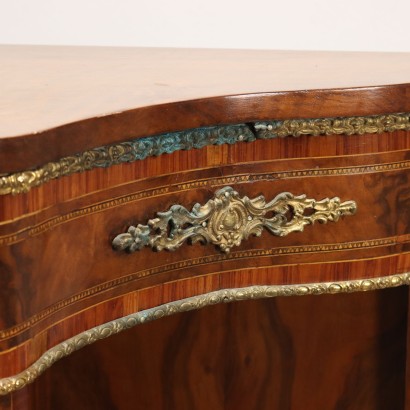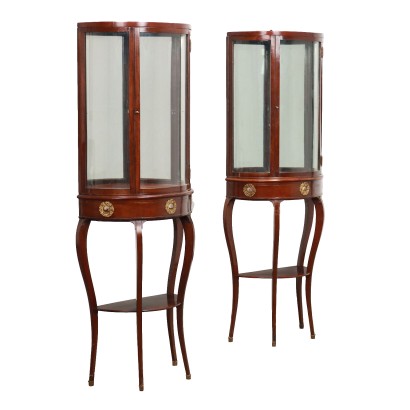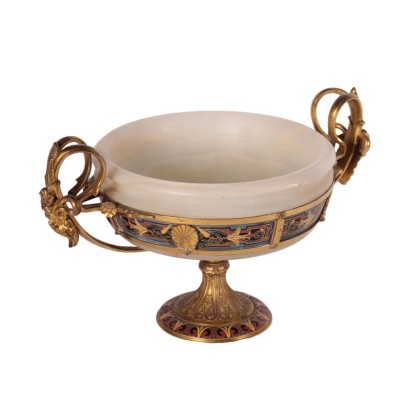Servant Late Victorian Walnut Burl England XIX-XX Century - England, Late XIX - Early XX Century
Features
England, Late XIX - Early XX Century
Style: High Victorian (1875-1900)
Age: 19th Century / 1801 - 1900
Origin: England
Main essence: Maple , Brazilian Rosewood , Walnut
Material: Gilded Bronze , Walnut Burl Veneer , Glass
Description
Late Victorian servant, England late 19th - early 20th century. Shaped front with pair of central glass doors, included within bracket sections. The whole surface is veneered in walnut briar, borders in bois de rose, inlays and threads in maple and stained maple. Applications in gilded bronze.
Product Condition:
Product that due to age and wear requires restoration and re-polishing. We try to present the real state of the furniture as fully as possible with photos. If some details are not clear from the photos, what is reported in the description will prevail.
Dimensions (cm):
Height: 110,5
Width: 179,5
Depth: 39,5
Additional Information
Style: High Victorian (1875-1900)
The Victorian style was born at the time when Queen Victoria ruled, and is characterized by linear wooden furniture, of a basically dark color and possibly with a mahogany and rosewood finish.Find out more about the Victorian movement with our insights:
FineArt: Writing desk, Arthur Blain
Age: 19th Century / 1801 - 1900
19th Century / 1801 - 1900Main essence:
Maple
Hard, light wood used for inlays. It grows mainly in Austria, but it is widespread throughout the northern hemisphere, from Japan to North America, passing through China and Europe. It is one of the lightest woods ever, tending to white, it is similar to lime or birch wood. The briar is used in the production of ancient secretaires .Brazilian Rosewood
It is a hard, light blond wood, but with strong red and pinkish veins, which is obtained from tropical trees similar to rosewood. Its veins are reminiscent of striped tulips, which is why it is called tulipwood in English-speaking areas. It is used for inlays, often combined with bois de violette. In the 1700s and 1800s it was highly appreciated and used in France and England for precious veneers. It gives off scent for decades if not centuries after curing.Walnut
Walnut wood comes from the plant whose botanical name is juglans regia , probably originally from the East but very common in Europe. Light or dark brown in color, it is a hard wood with a beautiful grain, widely used in antique furniture. It was the main essence in Italy throughout the Renaissance and later had a good diffusion in Europe, especially in England, until the advent of mahogany. It was used for solid wood furniture and sometimes carvings and inlays, its only big limitation is that it suffers a lot from woodworm. In France it was widely used more than anything else in the provinces. In the second half of the eighteenth century its use decreased significantly because mahogany and other exotic woods were preferred.Material:
Gilded Bronze
Walnut Burl Veneer
Glass
Other customers have searched:
Credenza, mobile da cucina, armadio, stipo, dispensa, madia..
Ecco qualche spunto dal nostro blog e da FineArt per scoprire di più sul tema credenze:
Leggi di più
Una credenza che dialoga con il passato
Credenza doppio corpo, tesoro di intagli e decorazioni
Piccolo stipo, grande arredo
Stipo toscano a cavallo tra XVI e XVII
Credenza Barium di Luciano Frigerio
Credenza, Mathieu Befort Jeune, Parigi, terzo quarto XIX secolo
Mobile anni '60
Highboard '503' Gianfranco Frattini per Bernini
Mobile bar anni '40
Mobile Bar anni '40 '50, manifattura italiana
Sull'antiquariato in generale dai un'occhiata anche a:
Classic Monday: da un pezzo dei nostri magazzini alla storia dell'antiquariato
L'antiquariato dalla A alla Z: il Dizionario dell'Antiquariato
Il dizionario dell'antiquariato - Lastronatura
Il dizionario dell'antiquariato - Mascherone
Il dizionario dell'antiquariato - Natura morta
Il dizionario dell'antiquariato - Opificio
Il dizionario dell'antiquariato - Pastiglia
Il dizionario dell'antiquariato - Savonarola
Il dizionario dell'antiquariato - Rosone
Leggi di più
Una credenza che dialoga con il passatoCredenza doppio corpo, tesoro di intagli e decorazioni
Piccolo stipo, grande arredo
Stipo toscano a cavallo tra XVI e XVII
Credenza Barium di Luciano Frigerio
Credenza, Mathieu Befort Jeune, Parigi, terzo quarto XIX secolo
Mobile anni '60
Highboard '503' Gianfranco Frattini per Bernini
Mobile bar anni '40
Mobile Bar anni '40 '50, manifattura italiana
Sull'antiquariato in generale dai un'occhiata anche a:
Classic Monday: da un pezzo dei nostri magazzini alla storia dell'antiquariato
L'antiquariato dalla A alla Z: il Dizionario dell'Antiquariato
Il dizionario dell'antiquariato - Lastronatura
Il dizionario dell'antiquariato - Mascherone
Il dizionario dell'antiquariato - Natura morta
Il dizionario dell'antiquariato - Opificio
Il dizionario dell'antiquariato - Pastiglia
Il dizionario dell'antiquariato - Savonarola
Il dizionario dell'antiquariato - Rosone











































